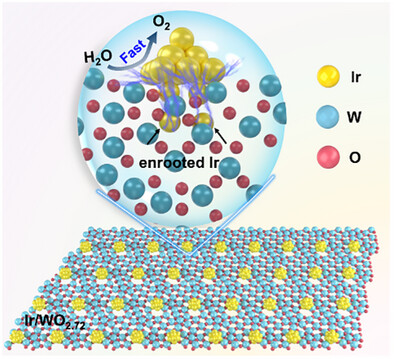Subnanometric Iridium Clusters Atomically Enrooted on Non‐Stoichiometric Tungsten Oxides for Boosting Acidic Oxygen Evolution Reaction
IF 19
1区 材料科学
Q1 CHEMISTRY, MULTIDISCIPLINARY
引用次数: 0
Abstract
The inherent thermodynamic instability of subnanometric clusters hinders their practical applications in electrocatalysis. Addressing this requires precise regulation of metal‐support interaction to firmly anchor subnanometric clusters onto suitable supports without compromising the exposure of active sites. Herein, a stabilization strategy utilizing non‐stoichiometric engineering is proposed to develop a series of enrooted‐type metallic Ir supported on tungsten oxides, including W

亚纳米铱簇原子根植于非化学计量的钨氧化物上,促进酸性析氧反应
亚纳米簇固有的热力学不稳定性阻碍了它们在电催化中的实际应用。解决这个问题需要精确调节金属-支撑相互作用,以牢固地将亚纳米簇锚定在合适的支撑上,而不影响活性位点的暴露。本文提出了一种利用非化学计量工程的稳定策略,以开发一系列钨氧化物(包括W18O49 (WO2.72), W20O58 (WO2.9)和WO3)负载的扎根型金属Ir。其中,最佳Ir/WO2.72催化剂表现出优异的酸性析氧反应(OER)性能,在10 mA cm−2下过电位为259 mV,质量活性为1202.5 a gIr−1,并且在150 h内具有良好的稳定性。实验表征和理论计算表明,独特的根状结构和缺氧WO2.72载体显著提高了负载Ir簇的锚定稳定性和分散性。有效地将它们限制在亚纳米尺寸(0.8纳米)。更重要的是,嵌入的Ir原子和WO2.72支架协同调节了Ir簇的电子结构,降低了它们的电子密度,优化了对含氧中间体的吸附,从而提高了OER性能。这项工作促进了稳定负载的亚纳米簇催化剂的发展,并为理解亚纳米尺度上金属-负载相互作用机制提供了重要的理论见解。
本文章由计算机程序翻译,如有差异,请以英文原文为准。
求助全文
约1分钟内获得全文
求助全文
来源期刊

Advanced Functional Materials
工程技术-材料科学:综合
CiteScore
29.50
自引率
4.20%
发文量
2086
审稿时长
2.1 months
期刊介绍:
Firmly established as a top-tier materials science journal, Advanced Functional Materials reports breakthrough research in all aspects of materials science, including nanotechnology, chemistry, physics, and biology every week.
Advanced Functional Materials is known for its rapid and fair peer review, quality content, and high impact, making it the first choice of the international materials science community.
 求助内容:
求助内容: 应助结果提醒方式:
应助结果提醒方式:


